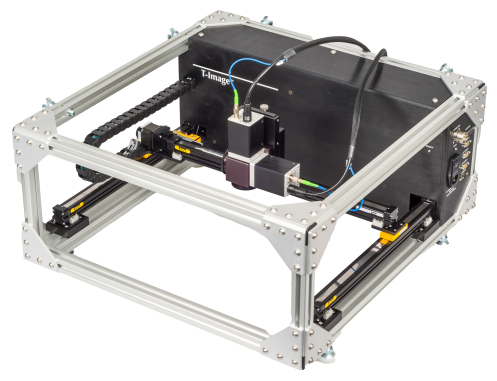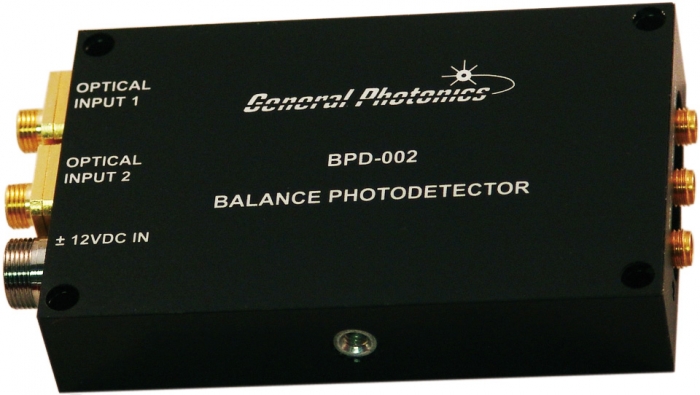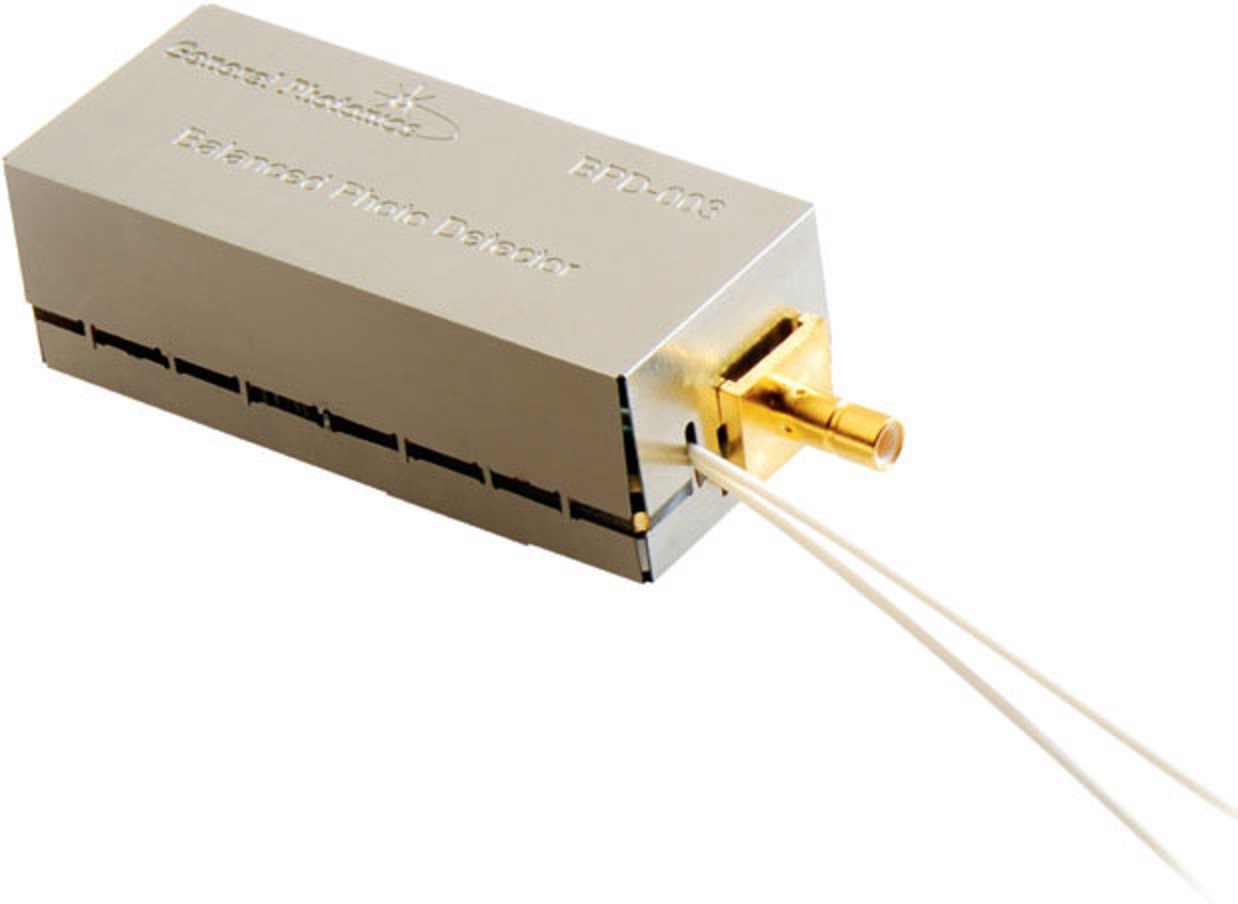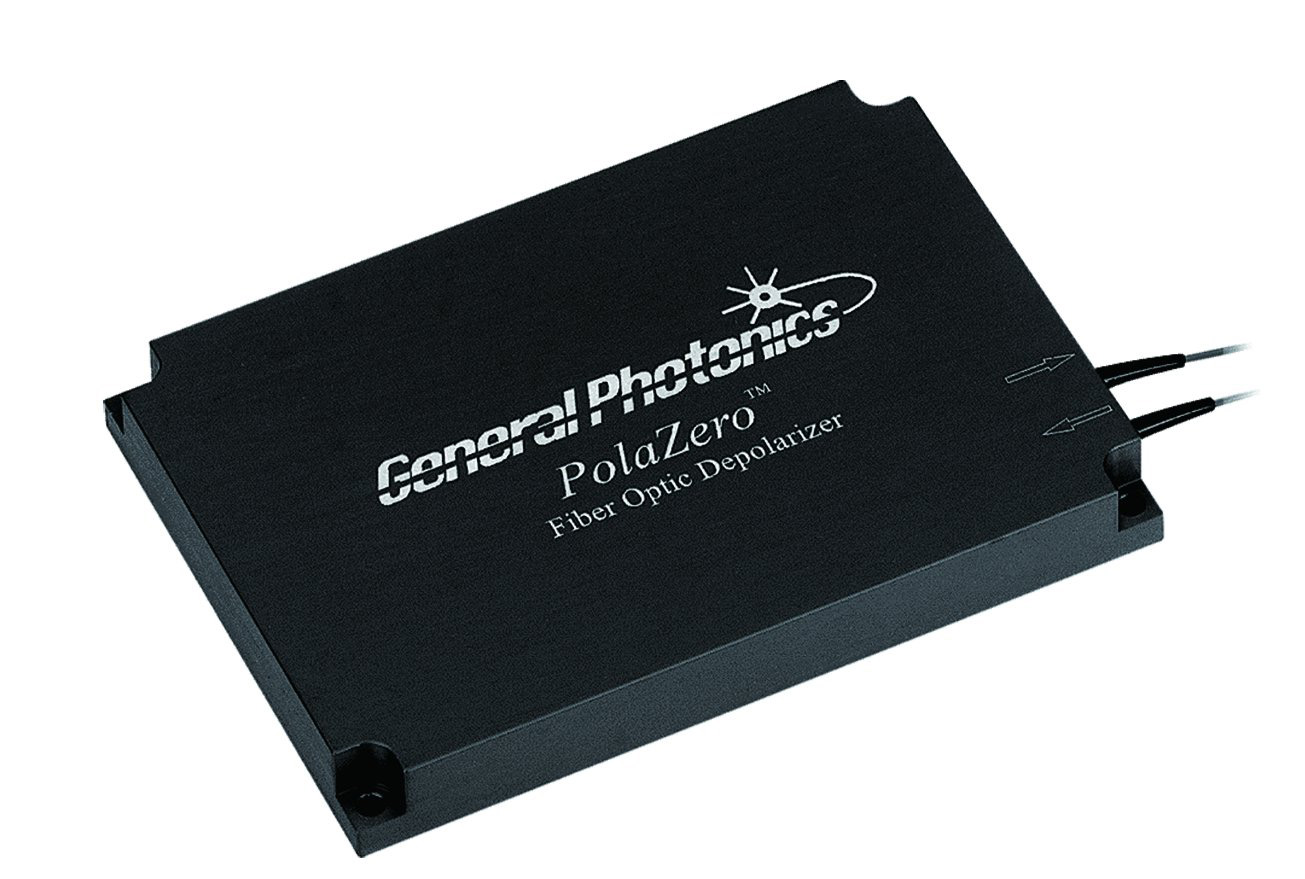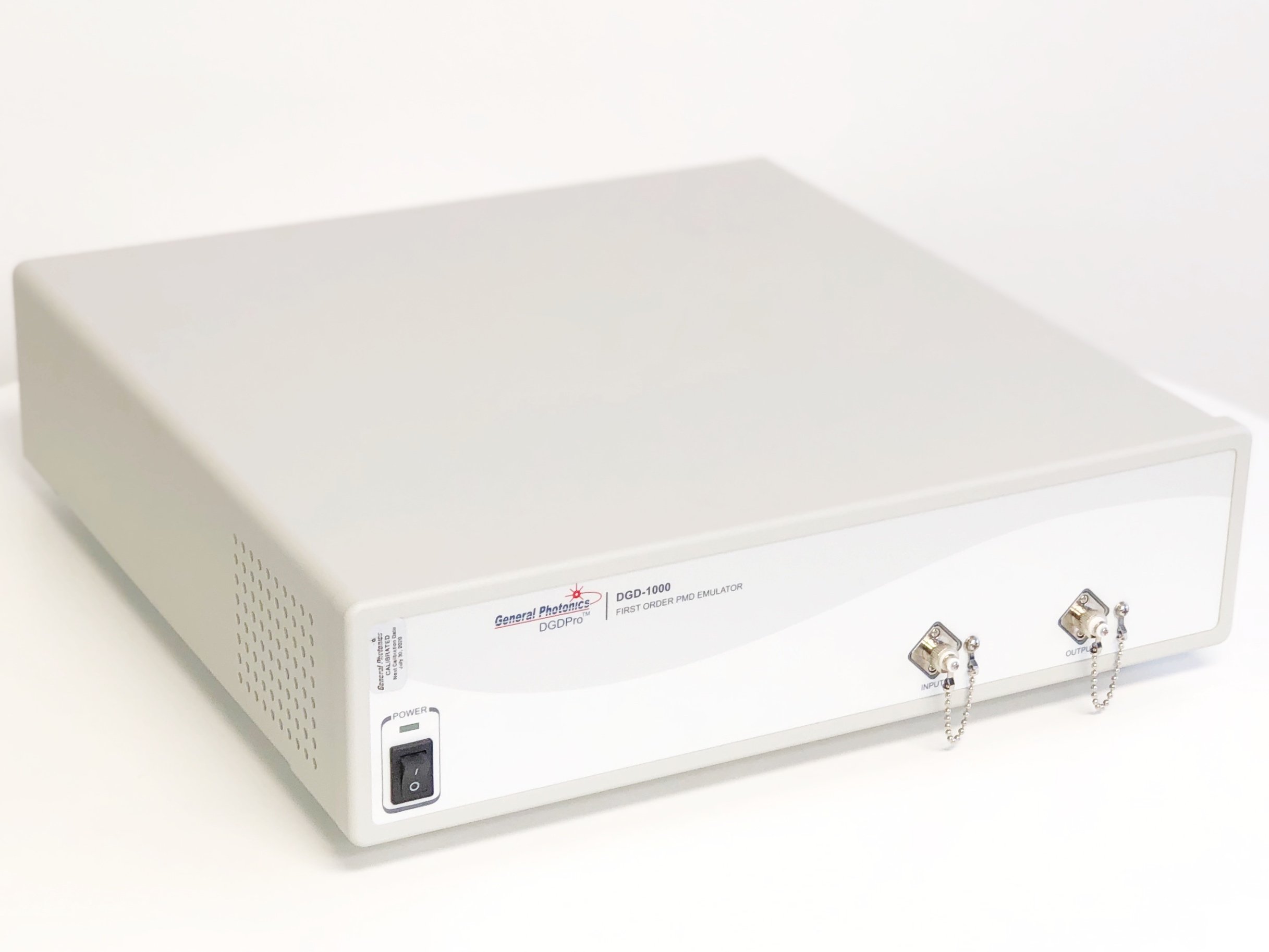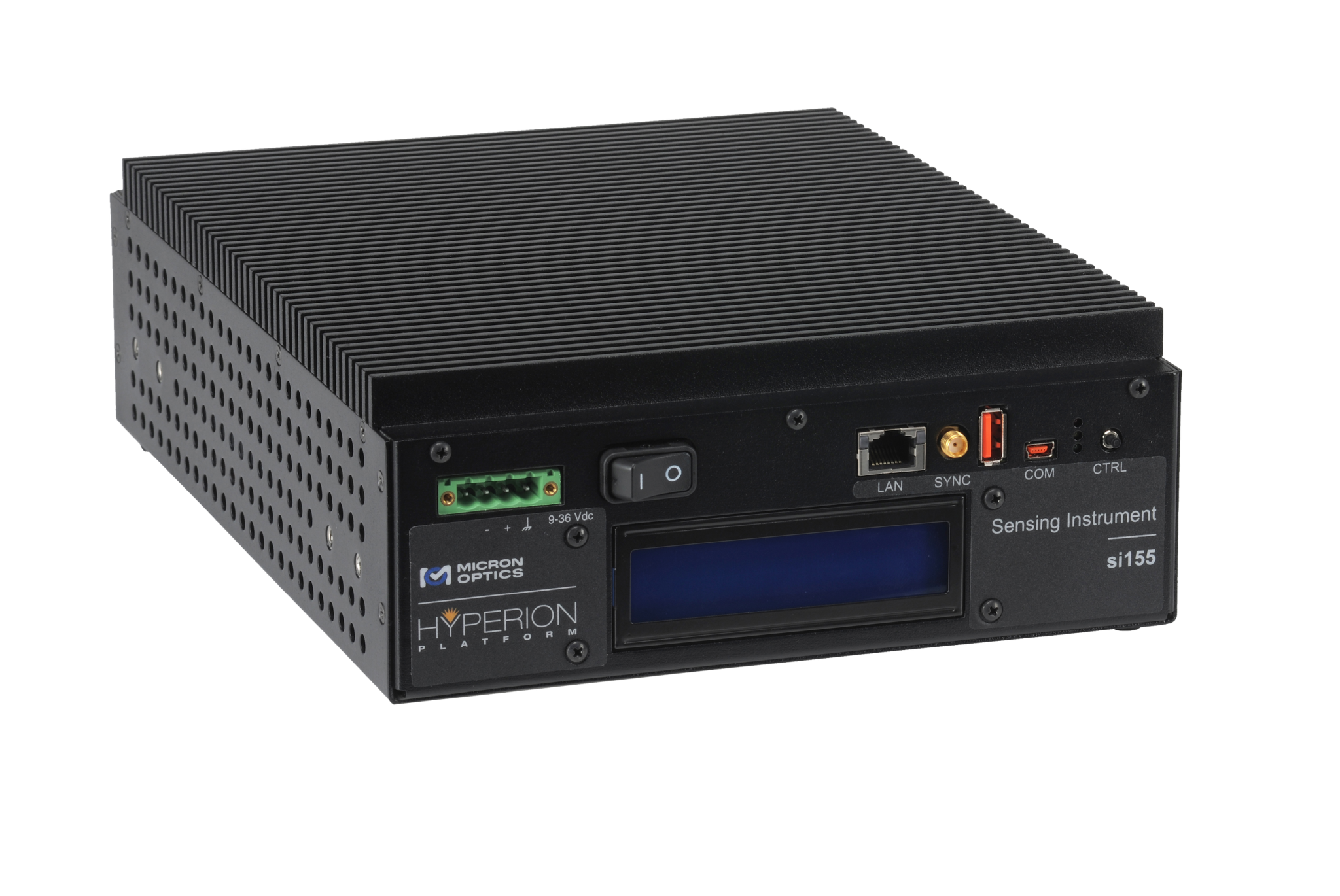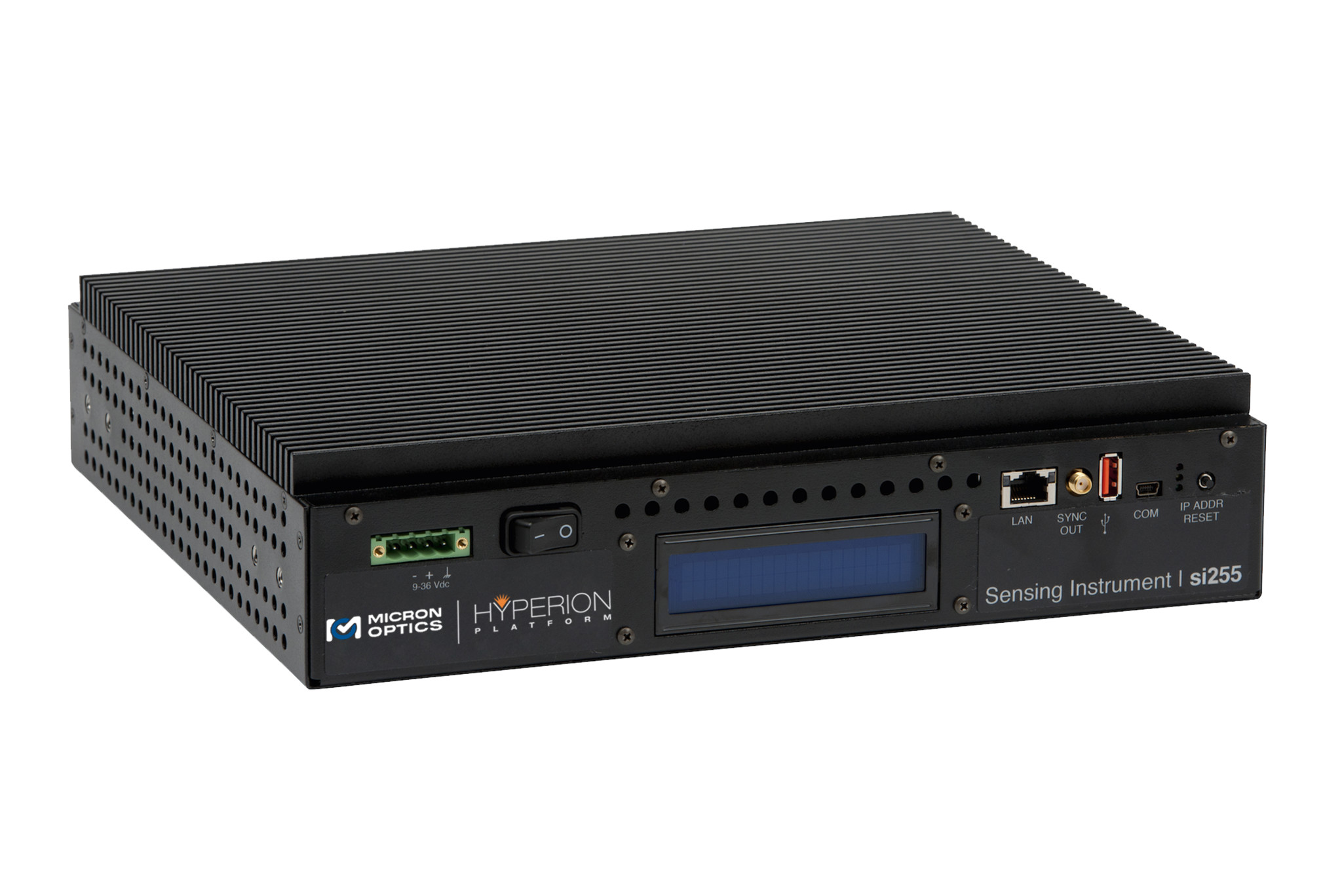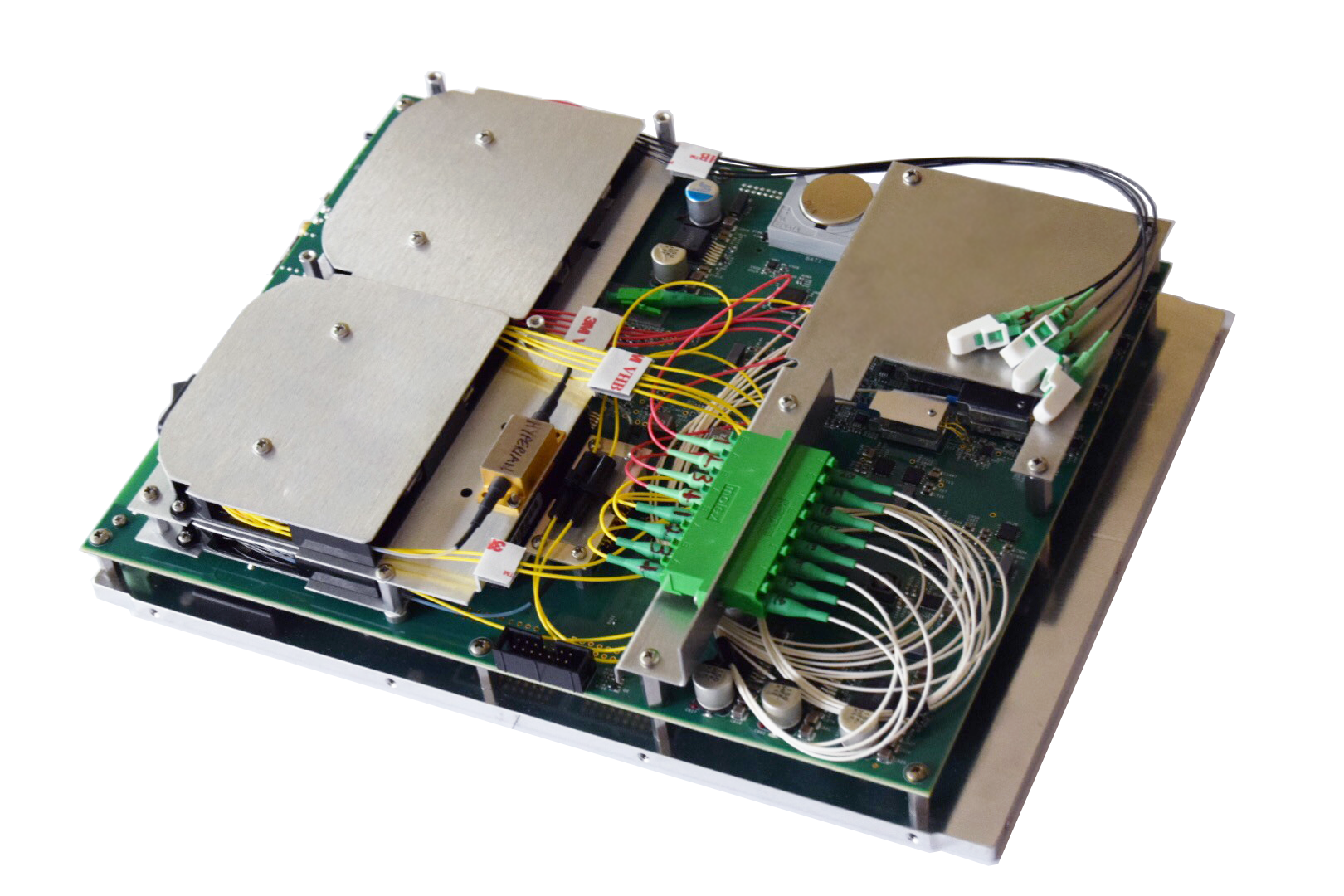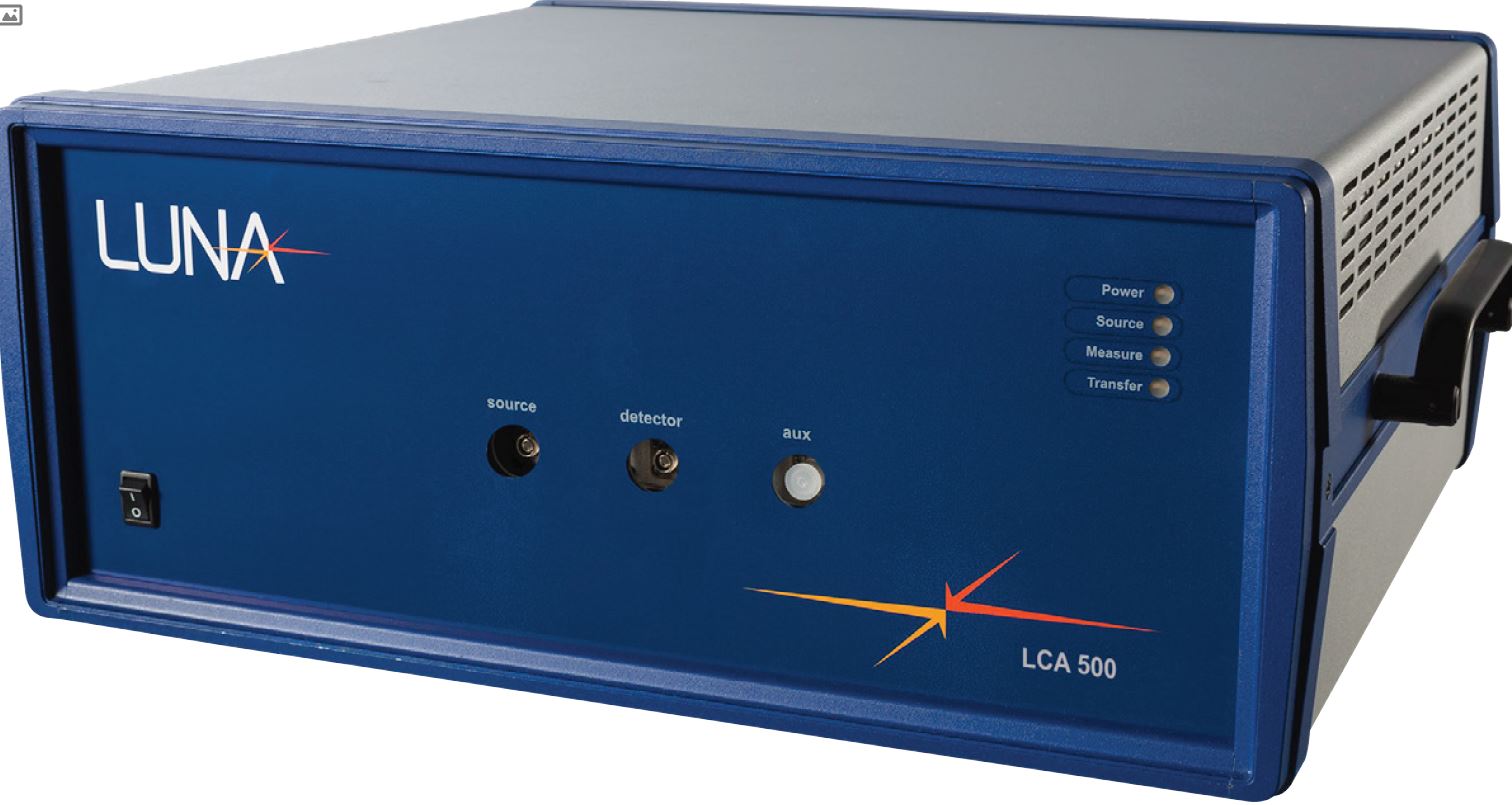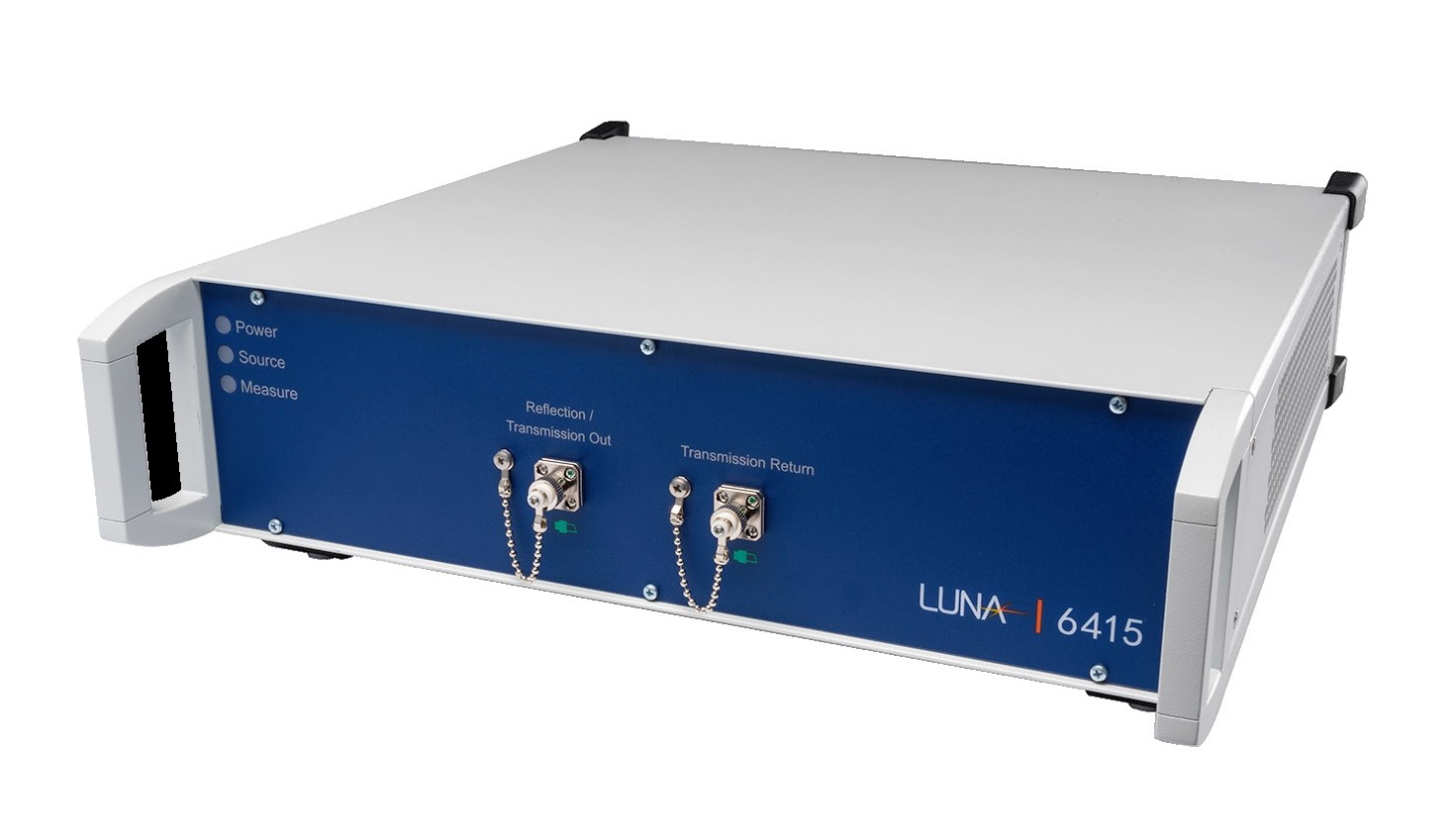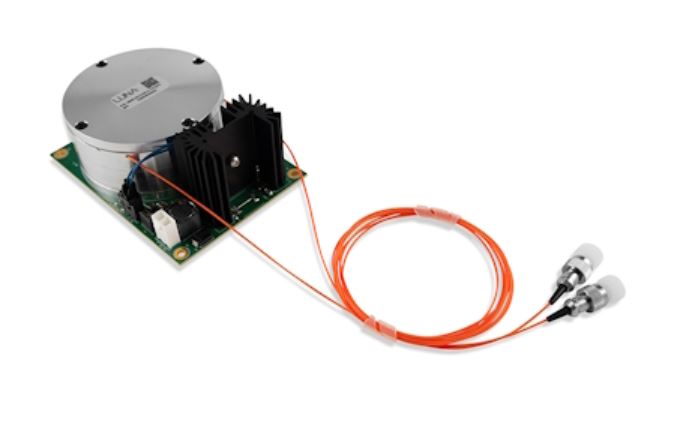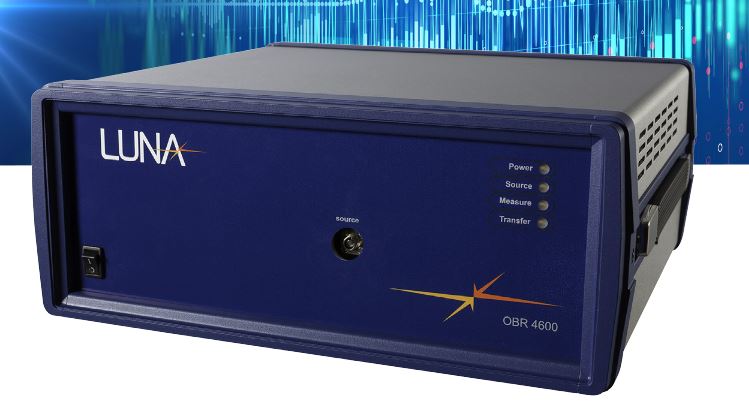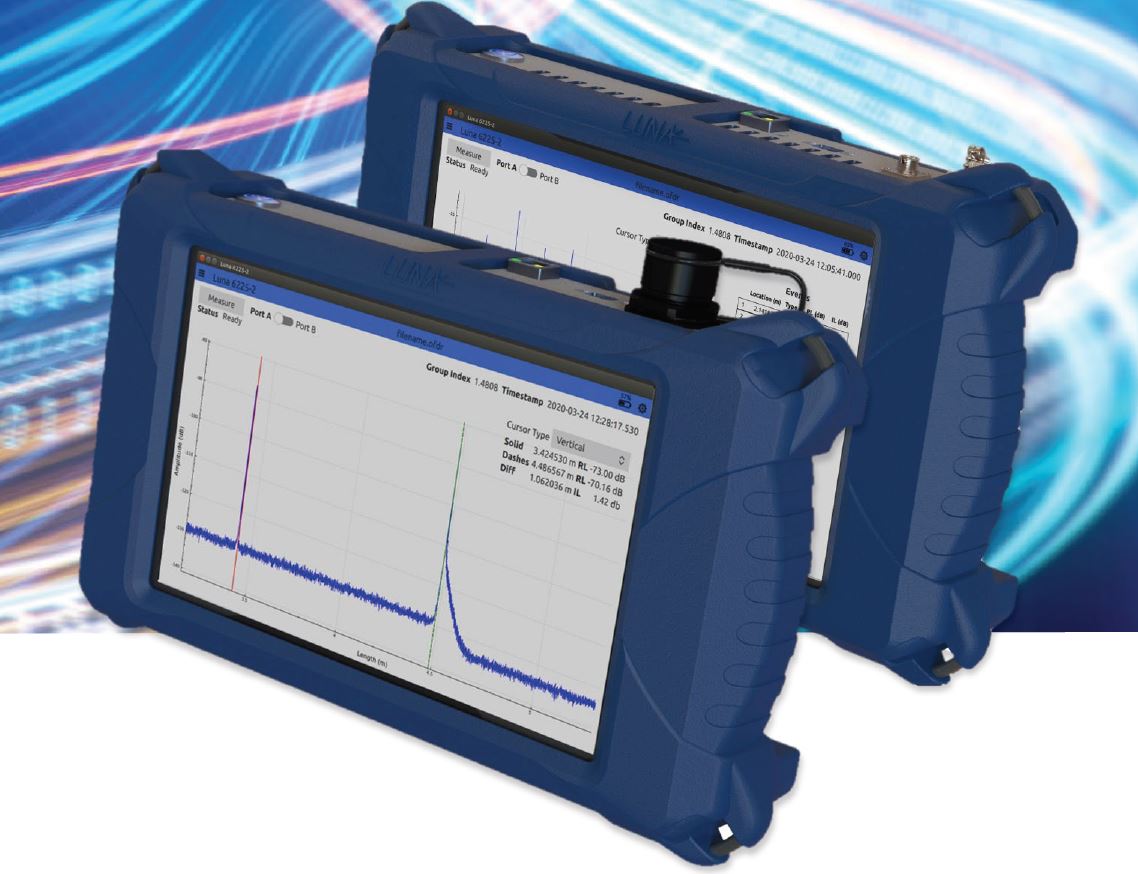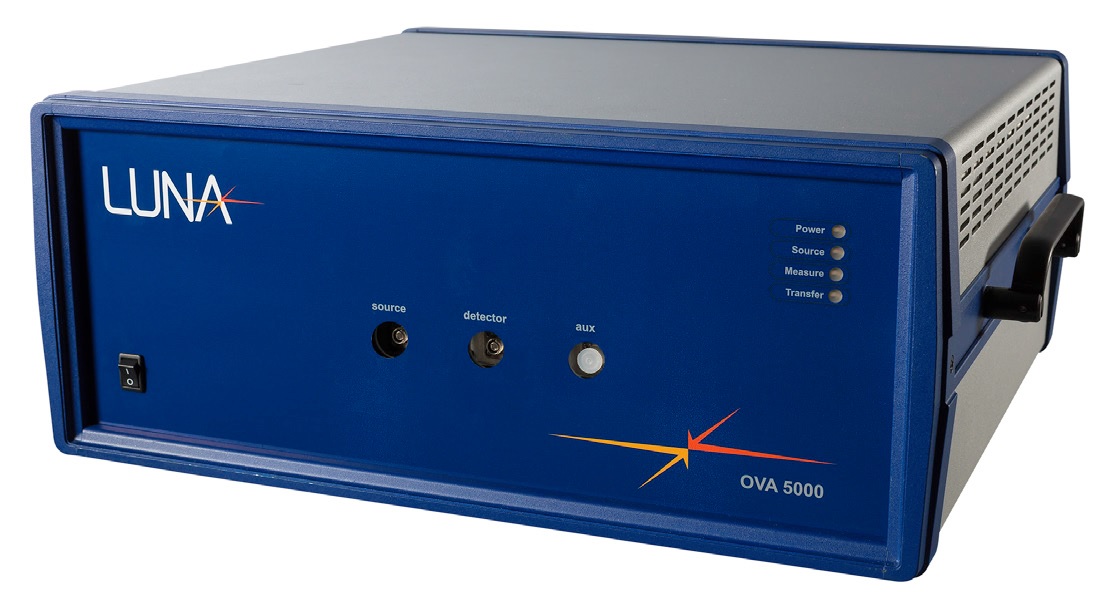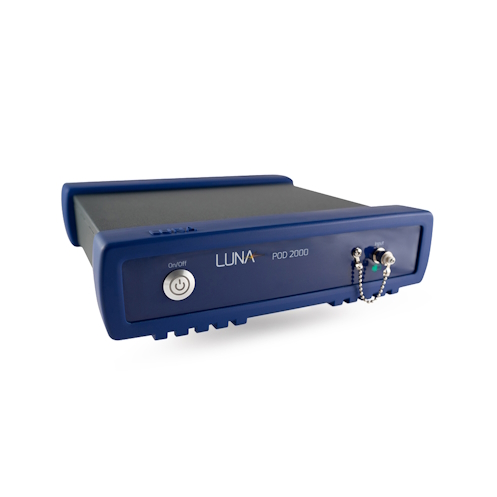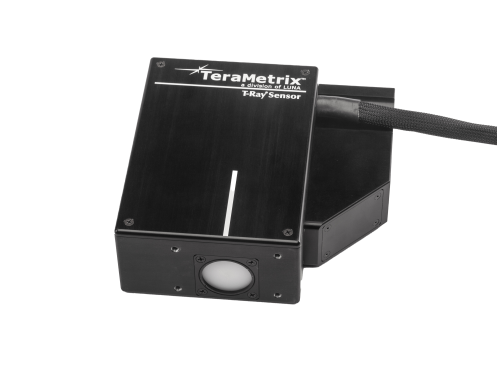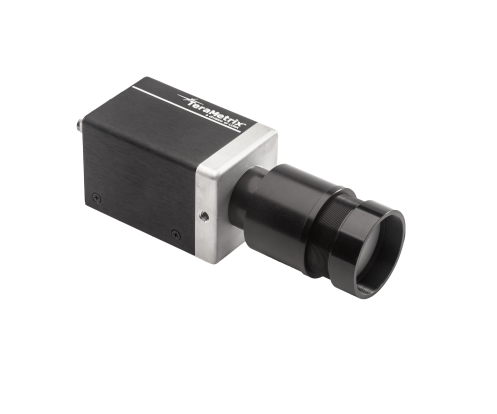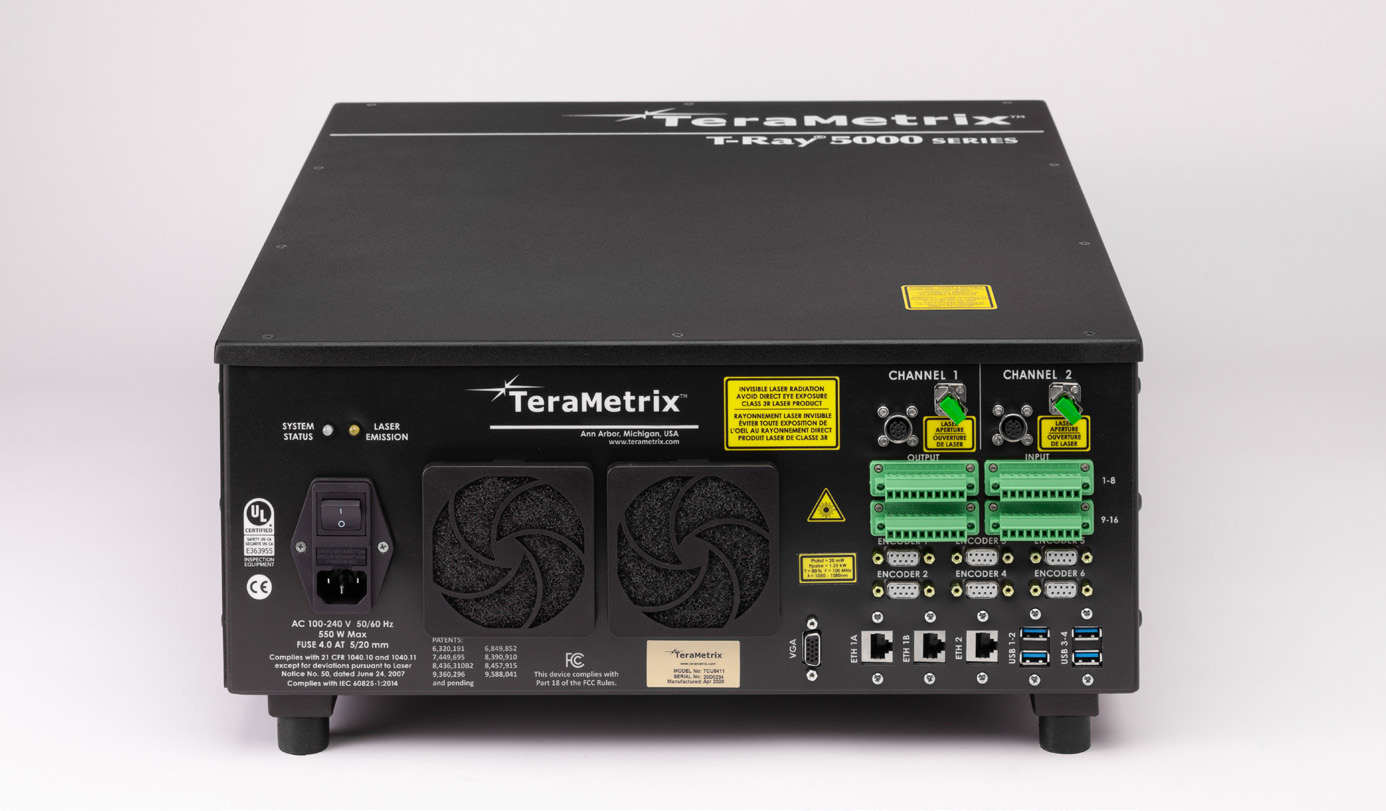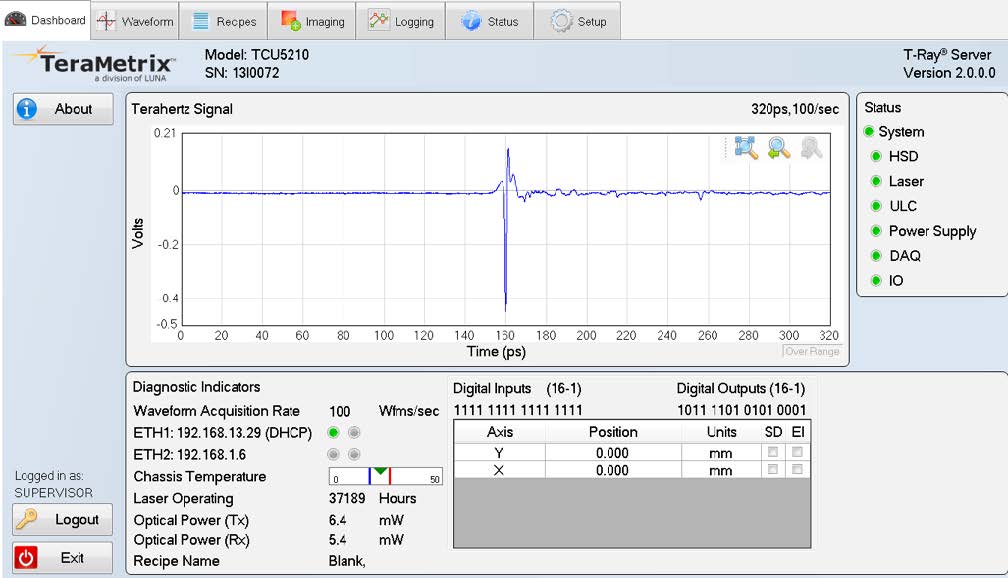Filter
–
Luna
Accessories and Fixturing for Terahertz Gauging & Imaging
Spectroscopy Rail; Collinear Adapter; Lens Options, T-Image Platform
Luna’s T-Ray ASR5001 is the first compact pulsed terahertz measurement system that is robust enough to be deployed in an industrial environment and has all of the flexibility provided by Luna’s fiber-coupled sensor heads in a rack mount package. With Luna’s range of accessories and fixturing devices, the T-Ray® 5000 can be configured to fit your specific application.
With its exceptionally long high-speed delay, the T-Ray® 5000 is ideally suited for spectroscopic investigations, providing spectral resolution down to 1.5 GHz at 100 Hz. The transmitter (HTS40nm) and receiver (HRS40n1) can be mounted on the T-Ray® ASR5001 spectroscopy rail to perform transmission spectroscopy measurements. A standard mount is provided to hold accessories or standard sample cards. The rail can accommodate lenses up to 150 mm working distance. An iris is provided on the sample holder to block any portions of the beam that may not be going through the sample. Tip-tilt stages provide easy optimization of the beam alignment to ensure maximum bandwidth.
Using the T-Ray® 5000 AXA40n1 collinear adapter, transmitter and receiver can be coupled to perform as an integrated collinear reflection transceiver. Alignment pins provide precise positioning. The adapter has two ports for the lens, so it can be assembled as right or left-handed. Reflection measurements are easily acquired because the transmitter and receiver share the same lens. Spatial resolution down to 100 µm has been obtained using this arrangement with a 25.4 mm focal length lens. The transceiver is ideal for reflection tomography.
When used with an HTS40nm and an HRS40n1, the assembled collinear transceiver based on ASR5001 or AXA40n1 will provide over 3.5 THz of bandwidth and SNR of 70 dB (ASR5001) or 60 dB (AXA40n1) respectively.
The T-Ray® 5000 HTS/HRS Transmitters & Receivers come standard with a 38 mm diameter lens in an adjustable lens tube. In addition to that, Luna offers T-Ray® 5000 lens options ranging from 38.1 mm to 76.2 mm and 152.4 mm in diameter, with focal lengths ranging from 25.4 mm and 76.2 mm to 152.4 mm and 304.8 mm, plus a collimating lens. Here, the “focal length” is the distance from the lens surface to the beam waist. Lens tubes that mount on the transmitter or receiver are also available for 38.1 mm and 76.2 mm lenses.
The lenses are manufactured from high-density polyethylene (HDPE) and are manufactured to an aspheric profile for high-quality focusing across a wide range of frequencies. Luna has specifically designed these lenses for use with their fiber-coupled transmitter and receiver sensor heads. When mounted on the front of a transmitter, the lens will provide a collimated or a focused beam. Use relay lenses in conjunction with a collimating lens on the sensor head. The collinear adapter (AXA5001) and the integrated collinear transceiver (HXC50xn) are compatible with 38.1 mm diameter lenses.
The T-Ray® 5000 MSL5201 T-Image platform can be positioned for horizontal or vertical scanning. The transmitter and receiver can be configured in transmission or collinear reflection geometry by using the collinear adapter. The MSL5201 can move at speeds up to 150 mm/s and can provide step resolutions below 30 µm. The motors are integrated with the required amplifier and encoder to allow high-quality images to be acquired at speeds up to 1000 pixels/s. The T-Ray® 5000 MSL5201 T-Image platform has an embedded motion controller that is configured by software running on the Terahertz Control Unit.
Key Features T-Ray® ASR5001 Spectroscopy Rail:
Easy Alignment Without an Optical Table
Sample Mounting Fixture With Integrated Iris
No Tool Required to Change Lenses
Accommodate Various Focal Length Lenses
Use to Measure Transmission Spectroscopy
Compatible With HTS40nm and HSR40n1
Rail Length: 60 cm
Dimensions: 60 x 15.5 x 7.5 cm
Weight: 2.0 kg
Key Features AXA40n1 Collinear Adapter:
Easily Switch to Transceiver Configration
Simple Orientation to Target
No Tool Required to Change Lenses
Expands System Capability
Use to Measure Layer Thickness
Use to Produce Scanned Images
Compatible With HTS40nm and HSR40n1
Variety of Focal Lengths Available
Right or Left Handed Operation
Polarization Extinction Ratio (PER): >20:1, Horizontal
Beam Diameter: 38 mm
Available Lens Focal Length: 25 mm, 75 mm, 150 mm, Collimating Lens
Mounting Hardware: ¼-20 Threaded Mounting Holes
Dimensions: 70 x 64 x 70 mm
Weight: 320 g
Key Features T-Ray® 5000 Lens Options:
Low Loss
Simple Alignment
No Tool Required for Installation
Compatible With Transmitter or Receiver
Compatible With Collinear Adapter
Lens Diameter: 38.1 mm, 76.1 mm, 152.4 mm
Lens Focal Length: 25.4 mm, 76.2 mm, 152.4 mm, 304.8 mm
Adjustable Lens Tubes Available for 38.1 mm, 76.1 mm Diameter Lenses
Key Features T-Ray® 5000 MSL5201 T-Image Platform:
Fiber-coupled to Allow Easy Movement
Image Resolution to 100 µm
Perfect for Field Work
Built to Operate Upright or Prone
Easy to Use Imaging Software Available
Transmission or Reflection Images
Multiple Lens Configurations Available
Scan range: 30 cm
Minimum Step: <30 µm
Focal Lengths: 25 mm, 75 mm, 150 mm
Power Supply Voltage Requirements: 110/240 VAC
Dimensions: 660 mm x 699 mm x 330 mm
Weight: 21.3 kg
Applications: Time Domain Spectroscopy; Time Domain Reflection Tomography; Defect Detection; Basis Weight Measurement; System Optimization & Verification; Reaction Kinetics Monitoring; Medical & Biological Research; Nondestructive Materials Inspection; Package Inspection; Semiconductor Wafer Inspection; Remote Threat Detection; Homeland Security
Product number:
SW11934
Manufacturer:
Luna
BPD-002 Balanced Photodetector
InGaAs Photodetector; 1060, 1310, 1550 nm; Aluminium Enclosure; Responsivity 0.7 mA/mW; RF Bandwidth 0-200 MHz; Transimpedance Gain 3×104 V/A
OCT and sensor systems require high-performance balanced photodetectors to increase system signal-to-noise ratio (SNR). General Photonics’ BPD-002 balanced photodetector module is specially designed for use in research and development, with ease of use and high performance as the primary design goals.
The BPD-002 device is fully enclosed in a compact, sturdy aluminium box with two optical input ports, a balanced RF output port, two 1 MHz monitor ports and a power supply port. With a bandwidth up to 200 MHz, a transimpedance gain larger than 30K and a saturation power larger than 130 µW, the BPD-002 balanced photodetector is ideal for integration into laboratory or commercial OCT, fiber sensor, and high-performance optical measurement systems.
Key Features:
Low Noise and High Common Mode Rejection Ratio (CMRR)
High Conversion Gain
Wide RF Output Bandwidth (3dB): DC to 200, 100, 50, 10 or 5 MHz
Wavelength Range: 1060, 1310 or 1550 nm ±50 nm
Compact Size: 97 x 61 x 19 mm
Photodetector Type: InGaAs
Photodetector Responsivity: 0.7 mA/mW @1310 nm
Transimpedance Gain: 3×104 V/A
CW Balanced Saturation Power: >130 μW @ 1310 nm
PD Input Power (linear range): 0 to 1 mW @ 1310 nm
PD Power Damage Threshold: 20 mW
Common Mode Rejection Ratio: >25 dB
RF Output Voltage Range (at 50 Ω): ±1.8 V
Applications: Optical Coherence Tomography; Fiber Sensing Interrogator; Instrumentation; Research and Development
Product number:
SW11299
Manufacturer:
Luna
BPD-003 OEM Balanced Photodetector
InGaAs Photodetector; 1060, 1310, 1550 nm; Aluminium Enclosure; Responsivity >0.5->0.8 mA/mW; RF Bandwidth 0-200 MHz; Transimpedance Gain 100×103 V/A
OCT and sensor systems require high performance balanced photodetectors to boost system signal-to-noise ratio (SNR). General Photonics’ BPD-003 OEM balanced photodetector module is specially designed for OEM applications in such fields, engineered for low cost and small size as well as high performance.
The BPD-003 device consists of an optical head and a post-amplification board with an SMA or SMB RF output connector. The optical head has two input fibers aligned with a pair of matched photodetectors, selected for high CMRR and sensitivity, followed by an integrated low-noise transimpedance amplifier (TIA) placed immediately after the photodetectors to amplify received signals with low noise and enhanced CMRR.
The integrated post-amplification circuit further conditions and amplifies the output of the detectors to a range of ± 3.5 V maximum. With a bandwidth of up to 200 MHz and a high conversion gain, the BPD-003 is ideal for integration into OCT, fiber sensor and high-performance optical measurement systems.
Key Features:
Very Low Noise
Excellent Common Mode Rejection Ratio (CMRR): >15 (40 to 200 MHz), >35 dB (DC to 40 MHz)
Photodetector Type: InGaAs
Photodetector Responsivity: >0.5 to >0.8 mA/mW
High Conversion Gain: >50 to >80 x 10³ mV/mW
Wide RF Output Bandwidth: DC to 200 MHz
Wavelength Range: 1060, 1310 or 1550 nm ±50 nm
Polarization Dependent Loss (PDL): <0.2 dB
Return Loss (RL): >45 dB
Maximum Input Power: 10 mW
Transimpedance Gain: 100 x 10³ V/A
Fiber Type: SMF-28, HI1060
Compact Size: 49.5 x 21.6 x 16.5 mm
Applications: Sensor Systems; Optical Coherence Tomography (OCT) Systems; Optical Measurement Systems; Fiber Sensing Interrogator; Instrumentation; Research and Development
Product number:
SW11300
Manufacturer:
Luna
DEP Depolarizer
1310, 1550 nm; IL 1.0 dB; DOP <5%; ER <0.5 dB; RL 55 dB
General Photonics’ DEP depolarizer module is a passive device (requiring no external power) that depolarizes laser output. The standard configuration can be used for coherence lengths less than 10 m. Custom units can be specified for coherence lengths of multiple kilometers.
The DEP polarizer is ideal for minimizing the polarization sensitivity of fiber optic sensor systems such as systems for quasi-distributed temperature and strain sensing based on fiber Bragg gratings (FBG), systems for distributed temperature and strain sensing based on Brillouin or Raman scattering and systems for distributed acoustic sensing based on Rayleigh scattering. It can also help to eliminate the effects of PDL or polarization sensitivity of optical components and instruments. Equally important, it can be used for depolarizing pump lasers to eliminate the polarization sensitivity of Raman amplifiers.
The DEP polarizer is packaged in a small (85 × 60 × 10 mm), rugged aluminium box, providing high performance and superb environmental stability. The internal structure and package size may be different depending on the coherence length or spectral width of the light signal to be depolarized. Contact AMS Technologies for an optimized configuration for your intended applications.
Key Features:
Customizable for Light Sources With Different Coherence Lengths
Low Output Degree of Polarization (DOP): <5%
Center Operating Wavelength: 1310, 1550 nm
Wide Operating Wavelength Range: ±50 nm
Low Insertion Loss: 1.0 dB Typical, 1.4 dB Maximum
Compact Size: 85 × 60 × 10, 85 x 85 x 15 mm, Larger Package for Coherence Length >200 m
No Power Source Required
Coherence Length of Light Source: 10 m Standard, Others Specify
Residual Extinction Ratio (ER): <0.5 dB
Return Loss: 55 dB
Optical Power Handling: ≥300 mW
Fiber Type Input: PM Panda Fiber
Fiber Type Output: SMF-28
Applications: Minimize Polarization Sensitivity of Fiber Sensors; Depolarize Pump Lasers; Remove Polarization Sensitivity of Raman Amplifiers; Eliminate Polarization Sensitivity of Optical Instruments; Eliminate the Effects of PDL; Can Be Integrated Into Remote Monitors
Product number:
SW11294
Manufacturer:
Luna
DGD-1000 PMD Source
DGD Range 0-200, 0-44 ps; DGD Resolution 0.2 ps; Single Band C, L, O, Dual Band CL; Max. IL 3.5 dB; Max. PDL 0.3 dB; RL >50 dB
Polarization mode dispersion (PMD) can seriously degrade the quality of high-speed fiber-optic data transmission. High-speed transceivers must meet stringent standards for PMD tolerance.
General Photonics’ DGD-1000 PMD Source/Emulator accurately and repeatably generates both high and low values of differential group delay (DGD) or first-order PMD. Both the DGD and PDL are very stable over time and wavelength within the performance band.
The DGD-1000 PMD source/emulator is available in different versions to accommodate the need for different wavelengths and DGD ranges.
Key Features:
Generates Differential Group Delay DGD up to 400 ps
DGD Range: 0 to 200 ps, 0 to 400 ps
DGD Resolution: 0.2 ps
DGD Change Rate: Up to 64 ps/s
Wavelength Range Single Band: C Band, L Band or O Band
Wavelength Range Dual Band: CL Bands
Insertion Loss (IL): ≤3.5 dB
Very Low Insertion Loss (IL) Variation Over DGD Range: 0.1 dB typ.
Very Low Polarization Dependent Loss (PDL) Over DGD Generation Range: 0.3 dB max., 0.1 dB typ.
Return Loss: >50 dB
Slow SOP Variation: <1 rad/min
Small DGD Variation Over Time: <0.1 ps Over 8 Hours
Extended Version Can Cover up to 600 ps as Special Order
Applications: System PMD Tolerance Testing; 1st Order PMD Performance Simulation
Product number:
SW11266
Manufacturer:
Luna
HYPERION si155 Fiber Optic Sensing Interrogator
1, 4 Channels; Dynamic Range 25 dB; Sampling Rate 10-5,000 Hz; Wavelength Range 1500-1620 nm; Wavelength Accuracy 1, 2 pm; Wavelength Stability 1, 3 pm; Optical Fiber Connectors LC/APC
Luna’s HYPERION si155 is an industrial-grade, fan-less fiber optic sensing interrogator. Featuring both static and dynamic full spectrum analysis, Luna’s HYPERION si155 robust, turn-key interrogator provides long-term, reliable and accurate measurements of hundreds of Fiber-Bragg Gratings (FBGs) or extrinsic Fabry-Perot (FP) sensors on 4 parallel, 160 nm wide channels.
The si155 interrogator features an all new, high-power, low-noise, ultra-wide swept wavelength laser with guaranteed absolute accuracy on every scan which is realized with Luna’s patented Fiber Fabry-Perot filter and wavelength reference technology.
The HYPERION platform, on which the si155 is based, features new and groundbreaking capabilities including high-performance on-board DSP and real-time FPGA processing. This enables rapid full-spectrum data acquisition and flexible peak detect algorithms of Fiber Bragg Gratings (FBG), Long Period FBGs (LPG), Fabry-Perot (FP) and Mach-Zehnder (MZ) sensors with low-latency access to data for closed-loop feedback applications.
HYPERION static full-spectrum optical interrogators measure the full optical spectrum of the optical sensor signals and can be equipped with a NIST absolute reference cell. The performance of the static interrogator module is characterized by high dynamic range and high absolute wavelength accuracy.
The HYPERION platform is now compatible with the ENLIGHT sensing analysis software, which provides a single suite of tools for data acquisition, computation, and analysis of optical sensor networks. More information on the ENLIGHT software can be found in the downloadable datasheet. The HYPERION platform also includes a comprehensive fully supported application programing interface (API) and LabVIEW, Python, Matlab, and C++ examples.
Whether an application requires static or dynamic real-time acquisition or periodic monitoring, Luna offers the right instrument for the job. Proven to be an essential element in reliable, long-term sensing measurement installations, Luna’s sensing instruments have been installed in hundreds of challenging applications all over the world, including large-span bridges in China, earthquake monitors in California, oil platforms in Brunei and marine vessels in the North Sea.
Key Features:
Full Spectrum at 1 kHz With 160 nm on 4 Parallel Channels Simultaneously, Eliminating the Need for Optical Switches
Dynamic and Absolute Measurements of Fiber Bragg Gratings (FBGs), Long Period FBGs (LPGs), Fabry-Perot (FP) and Mach-Zehnder (MZ) Optical Sensors From Detailed Optical Spectrum
Single and Continuous 25 dB Dynamic Range, Available to Each Sensor on Each Channel, Independent of Differential System Losses
Modes: Enhanced Visibility (10 Hz), Standard (100 or 1,000 Hz), High Speed (5,000 Hz)
Number of Channels: 1, 4
Wavelength Range: 1500 to 1620 nm
Wavelength Accuracy / Stability: 1 pm/1 pm, 2 pm/3 pm
Optical Fiber Connectors: LC/APC
Data Verification Key Guarantees only Valid Output. Each Data Set is Calibrated and Verified Against any Potential Sources of System Error (Coming Soon)
Proven Reliability and Longevity of the Luna Swept Wavelength Source, With Over 100 Million Hours Logged Since 2000
Dimensions: 206 x 274 x 79 mm
Applications: Fiber Optic Sensing of – Oil & Gas; Medical Devices; Industrial Measurements; Energy; Structures; Security; Aerospace
Product number:
SW11262
Manufacturer:
Luna
HYPERION si255 Fiber Optic Sensing Interrogator
4-16 Channels; Dynamic Range 25 dB; Sampling Rate 100-1,000 Hz; Wavelength Range 1460-1620 nm; Wavelength Accuracy 1, 2 pm; Wavelength Stability 1, 3 pm; Optical Fiber Connectors LC/APC
Luna’s HYPERION si255 is an industrial-grade, fan-less fiber optic sensing interrogator. Featuring both static and dynamic full spectrum analysis, Luna’s HYPERION si255 robust, turn-key interrogator provides long-term, reliable and accurate measurements of nearly 1000 of Fiber-Bragg Gratings (FBGs) or extrinsic Fabry-Perot (FP) sensors on 16 parallel, 160 nm wide channels.
The si255 interrogator features an all new, high-power, low-noise, ultra-wide swept wavelength laser with guaranteed absolute accuracy on every scan which is realized with Luna’s patented Fiber Fabry-Perot filter and wavelength reference technology.
The all new HYPERION platform, on which the si255 is based, features new and groundbreaking capabilities including high-performance on-board DSP and real-time FPGA processing. This enables rapid full-spectrum data acquisition and flexible peak detect algorithms of Fiber Bragg Gratings (FBG), Long Period FBGs (LPG), Fabry-Perot (FP) and Mach-Zehnder (MZ) sensors with low-latency access to data for closed-loop feedback applications.
HYPERION static full-spectrum optical interrogators measure the full optical spectrum of the optical sensor signals and can be equipped with a NIST absolute reference cell. The performance of the static interrogator module is characterized by high dynamic range and high absolute wavelength accuracy.
The HYPERION platform is now compatible with the ENLIGHT sensing analysis software, which provides a single suite of tools for data acquisition, computation, and analysis of optical sensor networks. More information on the ENLIGHT software can be found in the downloadable datasheet. The HYPERION platform also includes a comprehensive fully supported application programing interface (API) and LabVIEW, Python, Matlab, and C++ examples.
Whether an application requires static or dynamic real-time acquisition or periodic monitoring, Luna offers the right instrument for the job. Proven to be an essential element in reliable, long-term sensing measurement installations, Luna’s sensing instruments have been installed in hundreds of challenging applications all over the world, including large-span bridges in China, earthquake monitors in California, oil platforms in Brunei and marine vessels in the North Sea.
Key Features:
Full Spectrum at 1 kHz With 160 nm on up to 16 Parallel Channels Simultaneously, Eliminating the Need for Optical Switches
Dynamic and Absolute Measurements of Fiber Bragg Gratings (FBGs), Long Period FBGs (LPGs), Fabry-Perot (FP) and Mach-Zehnder (MZ) Optical Sensors From Detailed Optical Spectrum
Single and Continuous 25 dB Dynamic Range, Available to Each Sensor on Each Channel, Independent of Differential System Losses
Modes: Enhanced Visibility (10 Hz), Standard (100 or 1,000 Hz), High Speed (5,000 Hz)
Number of Parallel Channels: 4, 8, 16
Wavelength Range: 1500 to 1620 nm
Wavelength Accuracy / Stability: 1 pm/1 pm, 2 pm/3 pm
Optical Fiber Connectors: LC/APC
Data Verification Key Guarantees only Valid Output. Each Data Set is Calibrated and Verified Against any Potential Sources of System Error (Coming Soon)
Proven Reliability and Longevity of the Luna Swept Wavelength Source, With Over 100 Million Hours Logged Since 2000
Dimensions: 307 x 274 x 69 mm
Applications: Fiber Optic Sensing of – Oil & Gas; Medical Devices; Industrial Measurements; Energy; Structures; Security; Aerospace
Product number:
SW11263
Manufacturer:
Luna
HYPERION Single Board Fiber Optic Sensing Interrogator
1-4 Channels; Dynamic Range 17-45 dB; Sampling Rate 10-5,000 Hz; Wavelength Range 60-160 nm; Wavelength Accuracy 1 pm; Wavelength Stability 1 pm; Optical Fiber Connectors LC/APC
Luna’s HYPERION Single Board Interrogator is a high-performance optical sensing instrument that offers unmatched ease of integration for OEM systems. A full suite of software tools typically only available to high end instruments is among one of the many features of the HYPERION Single Board Interrogator.
Derived from Luna’s HYPERION si155 platform, the HYPERION Single Board Interrogator leverages the unmatched gains which are realized with Luna’s patented fiber Fabry-Perot filter and wavelength reference technology.
The HYPERION Single Board Interrogator features groundbreaking capabilities including high-performance DSP and real-time FPGA processing on-board, which enables rapid, flexible peak detect algorithms of Fiber Bragg Gratings (FBG), Long Period Gratings, Fabry-Perot (FP), Mach-Zehnder (MZ) sensors, and others with low-latency access to data for closed-loop feedback applications.
HYPERION static full-spectrum optical interrogators measure the full optical spectrum of the optical sensor signals and can be equipped with a NIST absolute reference cell. The performance of the static interrogator module is characterized by high dynamic range and high absolute wavelength accuracy.
The HYPERION Single Board Interrogator is compatible with the ENLIGHT sensing analysis software, which provides a single suite of tools for data acquisition, computation and analysis of optical sensor networks. More information on the ENLIGHT software can be found in the downloadable datasheet. This interrogator also includes a comprehensive application programing interface (API) and examples written in LabVIEW, Python, Matlab, C++ and C#.
Whether an application requires static or dynamic real-time acquisition or periodic monitoring, Luna offers the right instrument for the job. Proven to be an essential element in reliable, long-term sensing measurement installations, Luna’s sensing instruments have been installed in hundreds of challenging applications all over the world, including large-span bridges in China, earthquake monitors in California, oil platforms in Brunei and marine vessels in the North Sea.
Key Features:
Truly Turn-key Solution Providing Quick Start-up and Data Collection With Minimal Software or Electronic Design Required for System Implementation With Added Benefit of Reduced Cost
Dynamic Measurements of Fiber Bragg Gratings (FBGs), Long Period FBGs (LPGs), Fabry-Perot (FP) and Mach-Zehnder (MZ) Optical Sensors From Detailed Optical Spectrum
Data Verification Key Guarantees only Valid Output. Each Data Set is Calibrated and Verified Against an Available Permanent NIST Traceable Reference
Feature-rich ENLIGHT Software and API Support, Available at No Cost for Sensor Conditioning, Data Visualization and Data Saving Definitions
Deep, Continuous Dynamic Range of 17 to 45 dB is Available to Each Sensor on Each Channel, Independent of Differential System Losses
Modes: Enhanced Visibility (10 Hz), Standard (100 or 1,000 Hz), High Speed (5,000 Hz)
Number of Parallel Channels: 1 to 4
Wavelength Range: 60 to 160 nm
Wavelength Accuracy / Stability: 1 pm
Optical Fiber Connectors: LC/APC
Proven Reliability and Longevity of the Luna Swept Wavelength Source, With Over 100 Million Hours Logged Since 2000
Dimensions: 203 x 273 x 53.5 mm
Applications: Fiber Optic Sensing of – Oil & Gas; Medical Devices; Industrial Measurements; Energy; Structures; Security; Aerospace
Product number:
SW11264
Manufacturer:
Luna
LCA 500 Lightwave Component Analyzers
1270-1610 nm; Wavelength Resolution 1.6 pm; Loss Measurement Dynamic Range 60, 80 dB; Loss Measurement Resolution ±0.002, ±0.05 dB; Laser Sweep Rate 70 nm/s; Measurement Time 12, 55 s; Maximum Device Length 75, 150 m
Luna’s LCA 500 lightwave component analyzers are fast and accurate systems that are ideal for production test and quality control. The LCA 500 series provides the high throughput and connectivity needed for the manufacturing floor while delivering the extremely high resolution and sensitivity that is critical when testing and validating modern photonic devices and network subsystems.
The LCA 500 lightwave component analyzers provide single-scan measurements for testing a wide range of passive components from couplers to Optical Fibers and everything in between (Fiber Bragg Gratings, arrayed waveguide gratings, free-space filters, tunable devices, amplifiers, etc.).
Key Features:
Single Scan Measurement of Insertion Loss (IL), Return Loss (RL) and Polarization Dependent Loss (PDL)
High Resolution: 1.6 pm
High Sensitivity: 80 dB Dynamic Range
Integrated Tunable Light Source – No External Tunable Laser Needed
Measure in Transmission or Reflection
Compatible With C and L Band (LCA 500) or O Band (LCA 513)
Complete Full-band Measurement Scan in Less Than 3 s
User-friendly Interface
Wavelength Range: 1270 to 1610 nm
Wavelength Resolution: 1.6 pm
Loss Measurement Dynamic Range: 60, 80 dB
Loss Measurement Resolution: ±0.002, ±0.05 dB
Laser Sweep Rate: 70 nm/s, 1 Hz
Measurement Time: 12, 55 s
Maximum Device Length: 75 m (Reflection), 150 m (Transmission)
Applications: Testing of Passive Components like DWDMs, AWGs, Filters, Switches, Waveguide Gratings, Modulators, Couplers, etc.; High-resolution Measurements for Planar Light Circuits (PLCs) and Silicon Photonic Devices; Manufacturing Test and Quality Control; Flexible Tunable Laser Source splitters
Product number:
SW11260
Manufacturer:
Luna
Luna 6415 Lightwave Component Analyzer
OFDR Technology; Spatial Resolution 20 µm; Max. Device Length 20, 40 m; Center Wavelength 1546.69 nm; Wavelength Range 40 nm; Dynamic Range 15, 70 dB
The Luna 6415 lightwave component analyzer is a fast and simple-to-use analyzer for passive optical components and modules, extending Luna’s industry-leading optical frequency domain reflectometry (OFDR) platform to manufacturing test and quality control applications.
Unlike traditional passive component testers, Luna 6415 measures and analyzes the insertion loss (IL) and return loss (RL) distribution as well as length with a single instrument, working in either reflection or transmission.
The Luna 6415 lightwave component analyzer utilizes optical frequency domain reflectometry (OFDR) technology to measure backscattered or transmitted light as a function of distance. The system features extremely high sensitivity, 20 μm spatial sampling resolution and very fast scanning for high test throughput, making it an ideal testing tool for photonic integrated circuits (PICs) and silicon photonics.
By integrating both reflection and transmission measurements, Luna 6415 reduces the cost and complexity of test while increasing throughput and provides more complete test coverage of your component. The Luna 6415 lightwave component analyzer further simplifies your manufacturing test with an integrated tunable laser source , automated IL and RL calculations, self-calibration and very high scanning speeds for greater test throughput.
Key Features:
Return Loss (RL) and Insertion Loss (IL) Analysis
Trace Distributed Return Loss (RL) Over Length of Optical Path – Easily Measure Waveguide Scattering
Spectral Analysis of Return Loss (RL) and Insertion Loss (IL)
Detect and Precisely Locate Reflective Events and Measure Path Length
Speed, Resolution and Accuracy for Optimizing Production Test
High Spatial Sampling Resolution: 20 μm
Measurement Range: 20 m
Scan/Acquisition Rate: 6 Hz
Maximum Device Length: 20 m (Reflection), 40 m (Transmission)
Wavelength Range: 40 nm
Center Wavelength: 1546.69 nm
Maximum Optical Power: 5 mW
Dynamic Range: 70 dB (RL Measurement), 15, 70 dB (IL Measurement, Reflection / Transmission Mode)
Return Loss Measurement Sensitivity: -135 dB
Measurement Resolution: ±0.1 dB
Applications: Spatial RL Testing; Automated Insertion Loss (IL) Test and Analysis; Skew Measurement With Sub-picosecond Resolution; PLCs, Waveguide Devices, AWGs, ROADMs, etc.; Couplers, Switches, Beamsplitters
Product number:
SW11258
Manufacturer:
Luna
MMS-003 Miniature Multimode Scramblers
600-800 nm; IL ≤1 dB; Scrambling Frequency 725 ±5% kHz; Flatness <20%; Ripple <10%; RL ≤-50 dB
The presence of speckle patterns from a multimode fiber can pose challenges in applications that demand consistent and steady light distributions at the fiber output. Addressing this issue, the MMS-003 stands out as a compact multimode scrambler, specifically engineered to introduce randomness to multimode speckle patterns at a rapid frequency exceeding 725 kHz. This device ensures that the light distribution at the output appears both uniform and stable, particularly when observed by cameras or detectors with averaging times exceeding 80 ms. Furthermore, the all-fiber optical path in the scrambler minimizes insertion loss.
Key Features:
Operation Wavelength: 600-800 nm
Insertion Loss: ≤1 dB
Scrambling Frequency: 725 ±5% kHz
Flatness: <20%
Ripple: <10%
Return Loss: ≤-50 dB
Applications: DNA Sequencing, Multimode Fiber Sensing, Optical Imaging, Test And Measurement Of Multimode Fiber Devices
Product number:
SW11972
Manufacturer:
Luna
OBR 4600 Optical Backscatter Reflectometers
Zero Dead Zone; 1270-1610 nm; Resolution 10-250 µm; Scan Time 0.4-16 s; Max. Device Length 30-2,000 m; Dynamic Range 60, 80 dB; Backscatter-level Sensitivity -130 dB
OBR 4600 optical backscatter reflectometers are part of Luna’s award-winning OBR Optical Backscatter Reflectometer product line. Designed for component testing, short run network testing and troubleshooting, the OBR 4600 reflectometers enable ultra-high resolution reflectometry with backscatter level sensitivity.
The OBR 4600 reflectometers feature spatial resolution as fine as 10 µm, no dead zone and an extremely low noise floor. The OBR 4600 comes with an extensive range of options including a strain and temperature sensing package with maximum sensor lengths up to 2 km.
To increase the functionality of their OBR 4600 optical backscatter reflectometer, users can add the following options:
Spot Scan Option: Allows the user to narrow the scan range to 1 to 2 m area within the network under test. This reduces the time required to scan and also allows the user to focus exclusively on the area of interest.
Hard Shell Carrying Case Option: The OBR 4600 can be provided with a hard shell carrying case for applications that require portability or exposure to more rugged environments.
2 km Sensing Length Option: The OBR 4600 range can be extended up to 2 km with a 3 mm spatial resolution and no dead zone.
Software Development Kit Option: A selection of DLL files can be provided to allow users to customize their own test equipment user interface with the OBR 4600 operation.
Lightpath Analysis Software Option: Allows the user to program a go/no go check based on a pre-selected characterization of a component or network. This option is ideal for testing and can reduce a complicated analysis to a simple pass/fail end of line production test.
Distributed Temperature and Strain Sensing Package: This option allows the user to make strain or temperature measurements using sensors made with standard unaltered fiber optic cable that does not require fiber bragg gratings. The distributed sensing option can provide sub-cm spatial resolution with sensors up to 2 km.
Key Features:
“Zero Dead Zone” Reflectometers
Measure Insertion Loss (IL), Return Loss (RL), Distributed Loss, Distance, Polarization States, Phase Derivative and Group Delay
Easily Locate, Identify and Troubleshoot Macro-bends, Splices, Connectors and Breaks
Dual Display With Intuitive User Interface Allows to Simultaneously Determine Fault Location and Fault Magnitude and Perform Fault or Component Characterization
Highlight Selected Sections of the Scan and Perform an Analysis in the Frequency Domain
User-selectable Scanning Wavelength Range and Centerpoint
Fast Scanning: Measure 30 m with 10 μm Sampling Resolution in <7 s
Continuous High-speed Scanning: 1 m Segments at up to 3 Hz
Optional Spot Scanning Feature
Extended Range Option Provides 2 km Range With no Dead Zone
Wavelength Range: 1270 to 1610 nm
Maximum Wavelength Resolution: 0.02 pm
Maximum Device Length: 30 to 2,000 m
Sampling Resolution: 10 to 250 µm
Scan Time: 0.4 to 16 s
Measurement Rate in Spot Scan Mode: 0.15 to 3.7 Hz
Dynamic Range: 60, 80 dB
Backscatter-level Sensitivity: -130 dB
High-resolution C and L Band (OBR 4600) or O Band (OBR 4613) Capability
Applications: Easily Locate, Identify and Troubleshoot Macro-bends, Splices, Connectors and Breaks; Locate Insertion Loss (IL) Points at Every Point in the Network or Assembly – Eliminate Cutbacks; Test and Troubleshoot Short-run Networks (up to 2 km); Unprecedented Visibility into Miniaturized Components
Product number:
SW11256
Manufacturer:
Luna
OBR 6200 Optical Backscatter Reflectometers
Portable & Rugged; 1270-1610 nm; Resolution 80-200 µm; Measurement Time 10 s; Measurement Length Modes 10,50,100 m; Dynamic Range 15 (IL), 70 (RL) dB; RL Measurement Sensitivity -129 dB
Luna’s OBR 6200 series of optical backscatter reflectometers are portable and rugged ultra-high resolution reflectometers with backscatter-level sensitivity for testing short networks deployed in aerospace, naval, data center and industrial applications.
Troubleshoot fiber assemblies in the field to easily locate optical loss events with sub-millimeter resolution. Learn more about highest-resolution OTDR measurements available in the downloadable data sheet.
The OBR 6200 series utilizes optical frequency domain reflectometry (OFDR) technology to measure distributed return loss (RL) and insertion loss (IL) with high precision and dynamic range. The systems easily locate optical loss events with sub-millimeter spatial resolution.
OBR 6200 optical backscatter reflectometers are rugged battery-powered integrated systems with an intuitive touchscreen user interface, making them ideal for field maintenance applications. The user interface includes screen modes for interactive RL and IL measurement as well as automatic event detection.
Key Features:
Fully Portable and Rugged Optical Backscatter Reflectometers
Track and Analyze Return Loss (RL) and Insertion Loss (IL) Versus Length
Spatial Sampling Resolution: Down to 80 μm
Detect and Precisely Locate Reflective Events
Measure Optical Path Length With High Precision
Automatic Event Detection
One or Two Optical Channels
Available With IP65 and MIL-STD Certifications
Measurement Length Modes: 10, 50, 100 m
Sampling Resolution: 80 to 200 µm
Length Measurement Accuracy: <1 to <4 mm
Wavelength Scan Range: 4 to 10 nm
Center Wavelength: 1546.7 nm
Measurement Time: 10 s
Dynamic Range: 70 dB (RL Measurement), 15 dB (IL Measurement)
Return Loss Measurement Sensitivity: -129 dB
Measurement Resolution: ±0.1 dB
Applications: Troubleshoot Fiber Assemblies in the Field; Precisely Locate Insertion Loss (IL) Sites, High-RL (Return Loss) Connections, Fiber Breaks, etc.; Maintain Avionics, Aerospace, Naval and Industrial Networks; Verify Fiber Lengths of Data Center Interconnects; Troubleshoot Fiber Optic Sensing Systems
Product number:
SW11257
Manufacturer:
Luna
OVA 5000 Optical Vector Analyzers
Single-scan, All-parameter Measurement; 1270-1610 nm; Wavelength Resolution 1.6 pm; Loss Measurement Dynamic Range 60, 80 dB; Loss Measurement Resolution ±0.002, ±0.05 dB
Luna’s OVA 5000 Optical Vector Analyzer™ is the fastest, most accurate and economical tool for loss, dispersion and polarization measurements of modern optical networking equipment – and the only instrument on the market that is capable of full and complete all-parameter linear characterization of single-mode optical components in a single scan. The OVA 5000 provides comprehensive component characterization of dispersion compensation modules, AWGs, Fiber Bragg Gratings and many other optical devices.
The OVA 5000 uses an interferometric method to directly measure the linear transfer function (Jones Matrix) and simultaneously measure its four complex elements at every wavelength. From this data, all standard linear parameter measurements can be extracted with the highest dynamic range and accuracy available. The result is an extremely fast, high-resolution and accurate device characterization that is ideal for silicon photonics and other integrated photonics devices.
The OVA 5000 simultaneously performs these optical component characterizations every 3 seconds:
Insertion Loss (IL)
Return Loss (RL)
Dependent Loss (PDL)
Phase Response
Group Delay (GD)
Chromatic Dispersion (CD)
Polarization Mode Dispersion (PMD) / Second Order PMD
Min/Max Loss Due to Polarization
Impulse Response
Jones Matrix Elements
Phase Ripple – Linear and Quadratic
With the optical frequency domain reflectometer (OFDR) option, the OVA 5000 optical vector analyzer can also operate as a high-resolution reflectometer , delivering reflectometer measurements with 20 μm sampling resolution, “zero dead zone” and high sensitivity (>95 dB). An optional polarization analysis software add-on allows the OVA 5000 to measure, calculate and display the response of an optical component to simulated input polarization states, eliminating the tedious and difficult task of polarization alignment.
Key Features:
Single Measurement, All-parameter Analysis of Devices up to 150 m in Length
Full Characterization of Passive Devices in Under 3 s
Complete Polarization Response
Simultaneously Measure Complete Range of Parameters in One Single Scan: IL, RL, PDL, PMD, Second Order PMD, CD, GD, OTD Response, Jones Matrix Elements, Optical Phase Response
High-Resolution C and L Band (OVA 5000) or O Band (OVA 5013) Capability
Fast and Averaging Modes
Real-time Measurements
User-friendly Interface
Wavelength Range: 1270 to 1610 nm
Wavelength Resolution: 1.6 pm
Loss Measurement Dynamic Range: 60, 80 dB
Loss Measurement Resolution: ±0.002, ±0.05 dB
Applications: Analyze Planar Light Circuits and Silicon Photonic Devices; Characterize Optical Fiber Components; Measure Both Spectral Response and Time Delay Response; Improve Device Simulations and Models With Complete Transfer Function
Product number:
SW11259
Manufacturer:
Luna
POD 2000 High-Speed Polarimeter
Wavelenght Range (C-band version) 1500 – 1600 nm, 1550 nm typical; Wavelength Range (O-band version) 1260 – 1360 nm; 1310 nm typical; Dynamic Range -45 – 5 dB; SOP Uncertainty @ Calibration Wavelength 1.5°, Azimuth 1°, Ellipticity 1°; DOP uncertainty @ Calibration Wavelength -1.5% - 1.5%; Measurement Update Rate 100KHz; Measurement SOP Entire Poincaré Sphere
Luna’s POD 2000 is a DSP-powered polarimeter designed for high-speed polarization characterization, analysis, and monitoring. It utilizes four channels to simultaneously capture the four Stokes parameters, allowing it to measure an input light beam’s instantaneous state of polarization (SOP) and degree of polarization (DOP).
With a USB 2.0 interface, data can be directly transferred to a computer, enabling the polarimeter to monitor and analyze rapid polarization changes at a sampling rate of up to 100 KS/s. Additionally, it supports standard 100BASE-TX Ethernet for measurement and control.
The POD 2000 features a user interface that provides real-time graphical displays of the polarization state. This can be viewed on a Poincaré Sphere window for SOP traces or on an oscilloscope window for tracking polarization changes over time.
Key features:
High speed, SOP/DOP measurement with 100Khz date update rate
High accuracy
Dynamic range -45 to 5 dBm
None Stop or Continuous measurement as high as 100KHz update rate.
USB 2.0, Ethernet 100BASE-TX
SCIP command, C/C++ API, PC GUI
Trigger in/out
Applications: SOP/DOP monitoring, Polarization analysis, Scrambler DOP characterization, SOP statistics, PM fiber alignment to light sources, Polarization extinction ratio Analysis
Product number:
SW12006
Manufacturer:
Luna
T-Gauge® Sensors & Gauges for Terahertz Gauging & Imaging
Horizontal PER <20:1; Beam Diameter 20, 38, 40 mm; Lens 25,75,150 mm, Collimating; Min. Layer Thickness 10-50 µm; Single High-flex Umbilical
Luna’s T-Ray® 5000 measurement system is one of the fastest terahertz systems available on the market. Luna’s broad range of T-Gauge® sensor heads and gauges are paired with the T-Ray® 5000 Intelligent Terahertz Control Unit to create a complete system.
Transmitter and receiver are securely mounted inside the online sensor head’s sealed metal housing. The umbilical for the transceiver, containing the electrical and optical connections, is constructed with high flex rated electrical cable to allow for continuous scanning. When connected to a T-Ray® 5000 Control Unit, the online sensor heads will provide excellent waveform response, capable of providing detailed reflection measurement of layered surfaces or products.
The T-Gauge® HXC50yn is a high-performance online sensor head with full transceiver functionality and takes the robustness of the T-Ray® 5000 terahertz system to a new level with the ability to operate in industrial environments. Reflection measurement of thickness, multi-layer thickness, and basis weight are easily acquired. A variety of lenses are available to adjust the measurement spot size and working distance.
The “y” and “n” in the model number correspond to the focal length of the lens, and the type of terahertz transmitter, respectively – “y” = 4 for 75 mm lens and 5 for 150mm lens, “n” = 1 for a type 1 transmitter and 2 for a type 2 transmitter.
The T-Gauge® HXC51yn online sensor head adds functionality to the standard online sensor head with a virtual reference surface (VRS). Reflection measurement of thickness, multi-layer thickness, basis weight, and density are easily acquired. The VRS enables non-contact, calibration-less caliper thickness measurement as well as basis weight and density without reducing the open separation between the sensor and the product.
The T-Gauge® HXP51y2 online EPG sensor head allows measurement of thinner layers than the standard HXC50yn online sensor head. With higher bandwidth and higher signal to noise, the EPG opens new applications to terahertz process control. Coatings on metal or composite substrates and free standing films can be measured down to 10 µm (0.5 mil).
The T-Gauge® HSC50yn compact industrial sensor is designed for industrial applications that require a smaller footprint, a lighter weight or two output beams. These capabilities are met by the HSC50yn, which capitalizes on the new single fiber lighter weight umbilical, and a more compact design, to allow robot mounting. With proper attention to the configuration, it can be used to inspect two points on the same object. In the case of small diameter tubing, this can even be used to measure four orthogonal points at the same time.
The T-Gauge® SCS500n explosion-proof thickness measurement system takes the robustness of the T-Ray® 5000 to a new level with the ability to operate in flammable atmospheres, such as paint booths or coating facilities. Designed to be robot mountable and intrinsically safe, the T-Gauge® SCS500n Online Sensor Solution CID1 SCS500n is optimized for use in spray booth applications but can be used in other applications as well. The working distance of the sensor head is fixed at 115 mm, but other working distances may be available upon request.
The T-Ray® 5000 LSG500n line scan gauge (LSG) provides a handheld solution for high-speed scanning of a line 50 mm or 75mm in length. The line scan image is displayed on the screen of the handheld tool and can be analyzed by dedicated software for specific applications. Current software solutions can provide layer thickness measurements, detection of voids, or alignment of body panels with measurement of the vertical and horizontal offset between them.
The T-Ray® 5000 SPG500n single point thickness measurement gauge allows direct measurement of multiple layer objects with the press of a button. The modular nature of the measurement tool allows either straight-on or right-angle measurement tips. By using pulse time-of-flight (ToF) to make its measurements, the SPG500n has greater insensitivity to environmental and material variations that can lead to calibration inaccuracies, as well as operator inconsistencies. The measurement is fundamentally non-contact, but for hand-held use, a measurement tip is used to aid the user in positioning the object at the focus of the THz beam.
Key Features:
Full Transceiver Functionality, No Need for Separate Transmitter and Receiver
Collinear Design
Two Measurement Ports With Potential to Use Both Ports at Once (HSC50yn)
Cost-effective Plastic Lens
TPX Lens for Low Loss (HXP51y2)
Solvent Resistant Lens (SCS500n)
Hardened Case for Industrial Environment, Tolerant to Dirt and Dust in the Factory
Capable of Being Cleaned
Safe in Explosive Environments (SCS500n)
Single High-flex Umbilical, Long Umbilical Life in Scanner or Robot
Simple Orientation to Target
Variety of Focal Lengths Available: 25 mm (not All Models), 75 mm, 150 mm, Collimating Lens
Polarization Extinction Ratio (PER): >20:1, Horizontal
Beam Diameter: 38 mm (HXC51yn), 40 mm (HXC50yn, HSC50yn), 20 mm (HXP51y2)
Sweep Rate: ≤8/s (LSG500n)
Pointing Lasers to Guide Tool Alignment (LSG500n)
Gauge Direction: 0°, 90° (SPG500n)
Min. Layer Thickness: 50 µm (LSG500n), 10 µm (HXP51y2, Single Layer),
25 µm (HXP51y2, Buried Layer)
Passline Tolerance: ±2 mm (HXP51y2, 150 mm Lens)
Inexpensive to Replace if Damaged
Extended Lifetime
Replace Multiple Sensors
Supports VRS Functionality (HXC51yn)
Compatible With Various Motion Options
Improve Product Quality by Optimizing Production
Increases Product Gap for Density Measurements
Operating Temperature Range: 0°C to +50°C
Mounting Hardware: ¼-20 Threaded Mounting Holes
Dimensions: 250 x 150 x 150 mm (LSG500n), 128 x 66 x 178 mm (HXC50yn, HXC51yn), 128 x 66 x 178 mm (HXP51y2), 76 x 67 x 152 mm (HSC50yn), 64 x 76 x 267 mm (SPG500n)
Weight: 1.6 kg (HXC50yn, HXP51y2), 1.8 kg (HXC51yn), 1.1 kg (HSC50yn), 1 kg (LSG500n); 2 kg (SPG500n)
Applications: Measure Layer Thickness; Produce Scanned Images; Industrial Process Control like Commercial Roofing, Foam Density, Adhesive Foams, Paint or Coating Thickness, Plastic Extrusion, Asphalt Shingles; Nondestructive Materials Inspection Applications like Aircraft Coatings, Packaged Goods, Radomes, Spacecraft, Pipeline Repairs, Void Detection, Subsurface Defects or Inclusions, Art Conservation; Converting Applications like Paper Coating, Multilayer Films, Tires; Terahertz Line Scan Imaging
Product number:
SW11933
Manufacturer:
Luna
T-Ray® 5000 HTS/HRS Transmitters & Receivers for Terahertz Gauging & Imaging
Horizontal PER <20:1; Beam Diameter 38 mm; SNR 37-94.5 dB; Lens 25,75,150 mm, Collimating; Hot Swappable
Luna’s T-Ray® 5000 is the first compact pulsed terahertz measurement system that is robust enough to be deployed in an industrial environment. With Luna’s T-Ray® 5000 HTS/HRS transmitters and receivers, the T-Ray® 5000 can be configured to fit your specific application.
Operating in either reflection or transmission mode, the fiber-coupled transmitter/receiver heads deliver a picosecond duration time-domain terahertz pulse, allowing high speed, scanned images to be easily produced. Coupled with an HRS40n1 receiver, the transmitters provide bandwidth above 3.5 THz and signal to noise ratio above 70 dB (HTS40n1/2) or 55 dB (HTS40n3)
The T-Ray® 5000 HTS40n1 Transmitter Type 1 provides high output power with high spectral bandwidth. The enhanced low frequencies provide higher material penetration for imaging voids and disbonds in high-frequency scattering media. By maximizing low-frequency power, the HTS40n1 is ideal for applications where high material penetration is required for imaging, particularly in scattering or absorbing materials.
The T-Ray® 5000 HTS40n2 Transmitter Type 2 balances high output power with high spectral bandwidth and minimizes features following the pulse to allow high quality images and detection of multiple layers in reflection with less need for post processing of the waveform. By balancing bandwidth and power, the HTS40n2 is ideal for applications where both high-resolution imaging and broad spectral range are desired.
The T-Ray® 5000 HTS40n3 Transmitter Type 3 provides uniform signal to noise over an extended range for high-resolution spectroscopy, while minimizing waveform distortions after the pulse to allow high resolution temporal measurement of layer thicknesses without the need for post processing of the waveform. By providing a uniform signal to noise over a broad bandwidth, the HTS40n3 is ideal for applications where both high resolution and broad spectral range are desired.
The T-Ray® 5000 HRS40n1 Receiver provides high spectral bandwidth when coupled with any of the HTS40nm transmitters. The HRS40n1 provides bandwidth over 3.5 THz and signal to noise ratio above 70 dB. By embedding amplification close to the signal source, the receiver is able to produce high signal to noise, and eliminate the need for a lock-in amplifier.
Key Features:
Fiber-coupled to Allow Easy Movement
Ultra-broadband Measurement
Transmitted or Reflected Data Collection
Mates With Collinear Adapter (AXA40n1)
High Signal to Noise Ratio (SNR): 37 dB (@3.0 THz) to 94.5 dB (@0.1 THz), Typ., 1 min Average
Polarization Extinction Ratio (PER): <20:1, Horizontal
Beam Diameter: 38 mm
Hot-swappable With Other Transmitters/Receivers
Low Noise to Enable Rapid Data Collection
Adjustable Lens Tube for Focusing
Multiple Lenses Available: 25 mm, 75 mm, 150 mm, Collimating Lens
Mounting Hardware: ¼-20 Threaded Mounting Holes
Dimensions: 190.5 x 190.5 x 381 mm (HTS40n Transmitters), 70 x 64 x 70 mm (HRS40n1 Receiver)
Weight: 275 g
Applications: Terahertz Time Domain Spectroscopy; Gas, Liquid and Solid Spectroscopy; Nondestructive Materials Inspection; Package Inspection; Polymorph Discrimination; Semiconductor Wafer Inspection; Reaction Kinetics Monitoring; Medical and Biological Imaging Research; Sub-surface Corrosion Detection; Remote Threat Detection; Explosive Detection; Homeland Security; Converting Applications like Paper Coating, Multilayer Films, Tires
Product number:
SW11932
Manufacturer:
Luna
T-Ray® 5000 TCU52nm/TCU54nm Control Units for Terahertz Gauging & Imaging
1, 2 Channels; Dynamic Range 16 Bit; Sampling Rate 100, 1,000 Hz; Max. Measurement Range 12-100 mm; 6 High-speed Encoder Inputs
Luna’s T-Ray® 5000 measurement systems are amongst the fastest terahertz systems available on the market, with measured data processed within the control unit at a rate of up to 1 kHz. T-Ray® 5000 intelligent terahertz control units (TCUs) are the hearts of the system, monitoring and controlling all aspects of THz generation and detection. The TCU is paired with one of a variety of T-Gauge® Sensor heads to create a complete system.
The data generated by the T-Gauge® sensor heads and processed by the T-Ray® 5000 control units enable multiple measurements of a product simultaneously. One T-Gauge® sensor can measure the basis weight, caliper thickness, multi-layer thicknesses, density and moisture content of a sample in a single pass. Attached to a separate transmitter and receiver, the T-Ray® 5000 control units can perform spectroscopic measurements as well as transmission and reflection imaging.
The T-Ray® 5000 TCU52nm terahertz control unit monitors and controls all aspects of THz generation and detection, precisely delivering controlled optical signals to the terahertz transmitters and receivers, or the T-Gauge® Sensor Heads, enabling them to generate and receive terahertz signals.
The T-Ray® 5000 TCU54nm dual channel control unit is the same size, shape and weight as the single channel unit (TCU52nm), but with the added benefit of being able to control two terahertz sensors for multi-sensor applications.
The T-Ray® 5000 control units and accessories are linked with robust connection points and interfaces appropriate for industrial environments. Adequate connections are provided to allow seamless integration with most QC systems or experimental applications. The industry-standard interface connections make integration with the T-Gauge® Sensor straightforward.
Key Features:
Compact Enclosure
One (TCU52nm) or Two (TCU54nm) Reflection Sensors
Mates to Fiber coupled Sensor Head
Lightweight Umbilical, Single Fiber to Each Head (TCU54nm)
Integrated Data Processor
Standard Monitor and USB Connections
Digital Inputs Available for Measurement Control
Easy to Install
Integrates with Web Scanners and Robots
Provides Measurements in Engineering Units
Does Not Require Specialty Monitor or Keyboard
Triggers for Bin Boundaries or Data Tagging
Maximum Measurement Range: 12, 25, 50, 100 mm
Measurement Rate: 100 Hz, 1000 Hz
External Monitor Connection: VGA
USB Ports: 4
Ethernet Ports: 3
Digital Interface: 16 Inputs & Outputs
High-speed Encoder Inputs: 6
A/D Converter Dynamic Range: 16 Bit
Power Supply: 110/240 VAC, <4 A
Operating Temperature Range: 0°C to +50°C
Dimensions: 445 mm x 546 mm x 191 mm
Weight: 18.2 kg
Applications: Industrial Process Control Like Commercial Roofing, Foam Density, Coating Thickness, Plastic Extrusion, Asphalt Shingles; Nondestructive Materials Inspection Like Aircraft, Packaged Goods; Radome Inspection, Spacecraft, Pipeline Repairs; Converting Applications Like Paper Coating, Multilayer Films, Tires, Top and Bottom Balance of Steel Cord Tire Play (TCU54nm); Scientific Applications Like Terahertz Imaging (Transmission and Reflection), Time Domain Spectroscopy; Thickness Measurement of Material Opaque to THz; Differential Measurement as Coatings or Layers Are Applied (TCU54nm); OD and ID Measurement of Large Diameter Pipe (TCU54nm); Four Point Measurement of Small Diameter Tubing (TCU54nm); Two Point Calender Control
Product number:
SW11931
Manufacturer:
Luna
T-Ray® Server Software for Terahertz Gauging & Imaging
Modular SW Platform; Available Options T-Ray® Basic, T-Ray® T-Gauge, T-Ray® Imaging, SPG, T-Ray® Security, LSG; Client-server SW Architecture; XML Command Language; High-speed Data Analysis
Luna’s T-Ray® Server Software for the supplier’s T-Ray® 5000 compact pulsed terahertz measurement system is the most versatile terahertz waveform processing software available today. Built as a modular software platform, T-Ray® Server collects, analyzes, and serves terahertz waveforms and terahertz measurement data for a broad range of customer applications.
T-Ray® Server is a simple but flexible software environment structured in a server-client software architecture. It runs on a powerful single-board computer (SBC) embedded in the Terahertz Control Unit (TCU). This calculation engine collects and processes the terahertz waveforms to provide a broad range of measurements. These measurements can be accessed by using one of the T-Ray® Server Client programs, or by use of XML commands over one of the Ethernet ports of the SBC. This XML communication allows customers to write their own client programs that utilize the rich data available from the T-Ray® Server.
While T-Ray® Basic will allow configuration of the inputs and outputs of the TCU hardware and will stream THz waveforms at up to 1000 per second, the real power of T-Ray® Server is demonstrated when it is coupled with the various client programs available.
Key Features:
Available Options: T-Ray® Basic, T-Ray® T-Gauge, T-Ray® Imaging, SPG, T-Ray® Security, LSG (See Datasheet)
Designed for the Factory and the Researcher
Robust Database Structure to Ensure Continuity of Performance
Built on Embedded Operating System to Survive Power Failures
Client-server Architecture for Flexible Configuration
High-speed Data Analysis of Every Waveform
Powerful Script Interface for Flexible Waveform Analysis
XML Command Language for Integrating into Higher-level Control Systems
Reliable THz Measurements Based on 20 Years of THz Analysis Experience
Easy to Use Interface
Easy to Recall Analysis Recipes Stored in the System Database
Full Integration Support
Field-tested Software Platform
Local and Remote Access
Operational Security Through Multiple User Categories
Product number:
SW11935
Manufacturer:
Luna
Headquartered in Roanoke, VA, USA, Luna develops, manufactures and markets high-definition fiber optic sensing products and fiber optic test and measurement instrumentation . Luna's products are used to measure, monitor, protect and improve critical processes in the healthcare, telecommunications, energy and defense markets. Luna has become a recognized leader in transitioning science to solutions.
Luna’s high-definition fiber optic sensing technology allows engineers to test, modify and qualify their designs; efficiently, effectively, and accurately. The HYPERION series of fiber optic sensing interrogators provide many of the advantages of fiber optic systems and distinguishes itself by virtue of high spatial resolution.
On the test and measurement side, Luna provides diagnostic and test instrumentation that enables the complete characterization of optical components, assemblies and short-haul networks; providing substantial cost and time savings in the development, production, and maintenance of optical network equipment. Optical backscatter reflectometers (OBR series) enable ultra-high resolution reflectometry with backscatter level sensitivity, while lightwave component and optical vector analyzers extend Luna’s industry-leading optical frequency domain reflectometry (OFDR) platform to manufacturing test and quality control applications for passive optical components.

